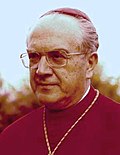Top Qs
Timeline
Chat
Perspective
Pontifical Commission for Vatican City State
Vatican City legislative body From Wikipedia, the free encyclopedia
Remove ads
The Pontifical Commission for Vatican City State (Latin: Pontificia Commissio pro Civitate Vaticana, Italian: Pontificia Commissione per lo Stato della Città del Vaticano) is the legislative body of Vatican City.[1] It consists of a president, who also holds the title of President of the Governorate and deputizes as the head of government of Vatican City, as well as six cardinals appointed by the Pope, the head of state of Vatican City, for five-year terms.[1]
Remove ads
The Pontifical Commission was created in 1939 by Pius XII. Laws and regulations proposed by the Commission must be submitted to the Pope through the Secretariat of State prior to being made public and taking effect.[1] Laws, regulations, and instructions enacted by the Commission are published in the Acta Apostolicae Sedis.[2]
Remove ads
Current members
As of 8 May 2025, the president and the members are:
Remove ads
Governorate of Vatican City State
This section needs additional citations for verification. (July 2021) |
Administrations and departments of Vatican City's government, including the Corps of Gendarmerie of Vatican City, the Vatican Observatory, the Vatican Museums and the Department of Pontifical Villas, which administers Castel Gandolfo, report to the Governorate.[4]
The functions of the Governorate include:
- Legal office
- Office for Personnel
- Office for Civil Records
- Archives
- Accounting Office
- Numismatic and Philatelic office
- Post and Telegraph office
- Shipping office
- Police Department (Corps of Gendarmerie of Vatican City)
- Tourist Information Office
- Department of Museums and Galleries (Vatican Museums)
- Department of Economic Services
- Department of Technical Services
- Vatican Observatory
- Castel Gandolfo
- Office for Archaeological Research
Remove ads
President
Summarize
Perspective
The president of the Pontifical Commission also serves as the Vatican City State’s de facto head of government, as the president of the Governorate of Vatican City State, an office that is distinct from the former title of governor of Vatican City.[5] In addition to their legislative role, the president is delegated executive authority for Vatican City by the Pope.[6][7] As a senior member of the Roman Curia, the president has usually been a cardinal.[8] Raffaella Petrini is the first religious sister to hold the position.
During a sede vacante, the term of the president ends, as do most other offices in the Curia. However, the holder of the office prior to the death or resignation of the pope becomes a member of the Commission that handles some of the functions of head of state until a new pope can be chosen, along with the former Cardinal Secretary of State and the Cardinal Camerlengo.[9]
The post of Governor of the Vatican City State (Italian: Governatore dello Stato della Città del Vaticano) was held by Marchese Camillo Serafini from the foundation of the state in 1929 until his death in 1952. The governor had power to appoint and supervise the people running the city state. During Serafini's lifetime, the powers of the governor were limited by Pope Pius XII in 1939 by the establishment of the Pontifical Commission for Vatican City State. No successor was appointed and the position was abolished on Serafini's death.
List
Remove ads
See also
Notes
- Pope Leo XIV (as Cardinal Robert Francis Prevost) was a member of the commission, until his election as pope on 8 May 2025.
- The pope wields all executive power in the Vatican City State; however, the pope, as head of state and de jure head of government, delegates the day-to-day exercise of this and the running of government departments to the President of the Governorate of Vatican City State, making them de facto head of government.
Remove ads
References
External links
Wikiwand - on
Seamless Wikipedia browsing. On steroids.
Remove ads














